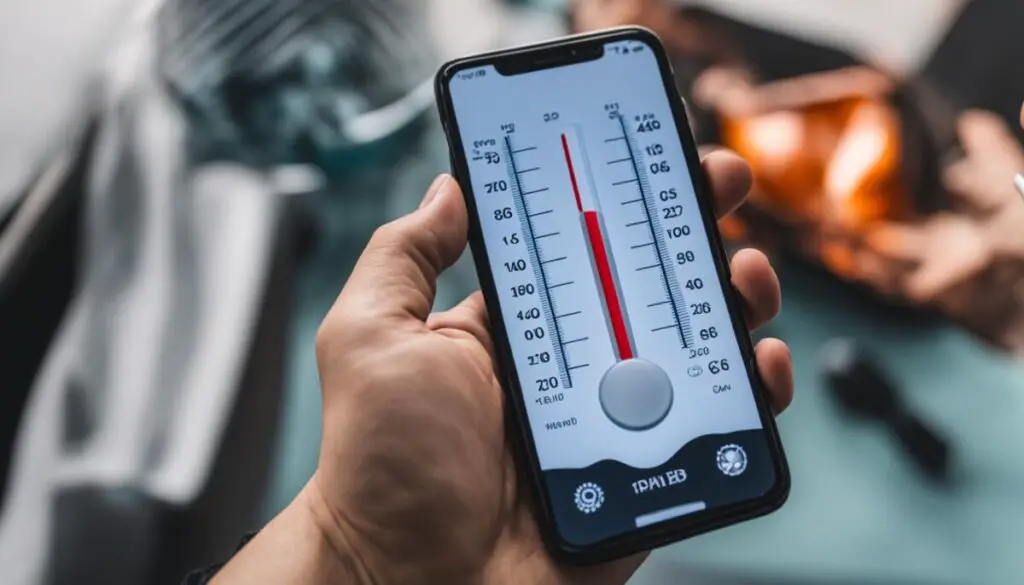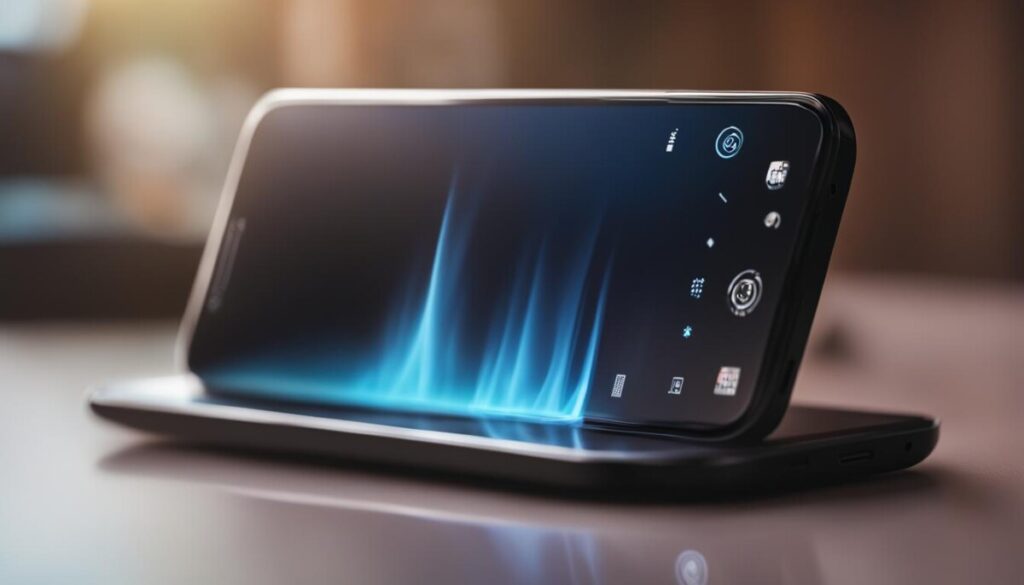Have you ever wondered why your phone suddenly overheats? It can be a frustrating and concerning experience, but understanding the causes can help you prevent it from happening again. In this article, we’ll delve into the reasons behind phone overheating and provide you with valuable tips to keep your device cool.
Key Takeaways:
- Exposure to direct sunlight, overloaded CPU, and running too many open apps are common causes of phone overheating.
- Power-intensive apps, faulty battery or charger cable, wireless charging, and prolonged gaming or streaming sessions can also contribute to increased phone temperatures.
- Preventing phone overheating involves keeping it out of direct sunlight, closing unnecessary apps, using manufacturer-approved chargers, and avoiding prolonged software updates.
- If your phone does overheat, you can cool it down by closing apps, removing it from direct sunlight, and using fan or air to dissipate the heat.
- It’s important to differentiate between normal phone heat and overheating issues to address them properly and protect your device.
Causes of Phone Overheating
When it comes to phone overheating, there are multiple factors that can contribute to this issue. Understanding the causes behind it can help you take necessary precautions and keep your device cool. Let’s explore some common causes of phone overheating:
Exposure to Direct Sunlight
Leaving your phone in direct sunlight can amplify its temperature, leading to battery drainage and potential damage to internal components. It is advisable to keep your phone away from direct sunlight, especially during hot summer days.
Overloaded CPU
The CPU (Central Processing Unit) is responsible for running various processes and apps on your phone. An overloaded CPU can generate excess heat, causing your phone to overheat. Running too many open apps can consume CPU power and memory resources, contributing to increased phone temperatures.
Power-Intensive Apps
Power-intensive apps, such as those with augmented reality or heavy graphics loads, can put a significant strain on your phone’s CPU and GPU (Graphics Processing Unit). This strain can cause your phone to generate heat, particularly during extended usage periods.
Faulty Batteries or Charger Cables
Faulty batteries or charger cables can lead to excessive heat generation while charging your phone. It is crucial to use manufacturer-approved chargers and cables to prevent any potential overheating issues.
Wireless Charging
Although wireless charging is convenient, it can contribute to increased phone temperatures. Wireless charging technology generates heat during the charging process, which can cause your phone to overheat if left on the charging pad for an extended period.
Prolonged Gaming or Streaming
Engaging in prolonged gaming sessions or streaming video content can put a significant strain on your phone’s CPU and GPU, resulting in increased heat production. It is advisable to take breaks and allow your phone to cool down to avoid overheating.
Software Updates
Software updates can temporarily increase power usage, leading to heat generation in your phone. While these updates are essential for optimal device performance, it is recommended to give your phone some time to cool down after completing the updates.
Malware or Viruses
Malware or viruses can hijack your phone’s resources, causing increased heat production. It is crucial to have reliable antivirus software installed on your phone to prevent malware-related overheating.
By understanding the various causes of phone overheating, you can take proactive measures to prevent this issue and ensure the longevity and optimal performance of your device.
How to Prevent Phone Overheating
Preventing your phone from overheating is essential to ensure its optimal performance and longevity. By following these simple tips, you can keep your device cool and avoid potential damage.
Avoid Heat Sources
One of the primary causes of phone overheating is exposure to direct sunlight or hot environments. To prevent overheating, keep your phone away from direct sunlight and avoid leaving it in a car or on a sunny windowsill. These actions can help maintain a safe temperature for your device to operate efficiently.
Manage Apps and Processes
Running too many open apps simultaneously can strain your phone’s CPU and lead to overheating. To prevent this, close unnecessary apps and only run power-intensive apps when necessary. This practice reduces the load on the CPU and prevents it from generating excessive heat.
Use Manufacturer-Approved Chargers and Cables
The type of charger and cable you use can impact your phone’s temperature. To prevent battery-related overheating, always use manufacturer-approved chargers and cables. These are designed specifically for your device and ensure safe charging without generating excessive heat.
Avoid Wireless Charging
While wireless charging may be convenient, it can contribute to increased phone temperatures. To prevent overheating, it’s best to avoid wireless charging and opt for a wired charging method instead.
Limit Gaming and Streaming
Prolonged gaming sessions or streaming activities can put a significant strain on your phone’s CPU and GPU, leading to overheating. To prevent excessive heat generation, limit your gaming and streaming sessions and give your phone breaks to cool down.
Avoid Prolonged Software Updates
Software updates can temporarily increase your phone’s power usage and heat generation. To prevent overheating, avoid performing software updates during extended periods of use or when your phone’s battery is already low.
Install Reliable Antivirus Software
Protecting your phone from malware or viruses is crucial not only for security but also for preventing overheating. Installing reliable antivirus software on your Android device can help detect and eliminate malicious programs that can hijack your phone’s resources and cause it to generate excessive heat.

| Tip | Description |
|---|---|
| Avoid heat sources | Keep your phone away from direct sunlight and hot environments |
| Manage apps and processes | Close unnecessary apps and only run power-intensive apps when necessary |
| Use manufacturer-approved chargers and cables | Choose chargers and cables designed specifically for your device to prevent battery-related overheating |
| Avoid wireless charging | Opt for wired charging methods to minimize heat generation |
| Limit gaming and streaming | Take breaks and allow your phone to cool down during gaming or streaming sessions |
| Avoid prolonged software updates | Avoid performing software updates when your phone is already under heavy use |
| Install reliable antivirus software | Protect your phone from malware and viruses that can cause excessive heat generation |
How to Cool Down an Overheated Phone
If you find your phone overheating, there are several troubleshooting steps you can take to cool it down and prevent potential damage. The following solutions are recommended by experts:
1. Close All Apps and Remove Phone from Direct Sunlight: Overheating can be worsened by running multiple apps simultaneously and exposing the phone to direct sunlight. Close all unnecessary apps and move the phone to a cool, shaded area to help dissipate heat.
2. Remove the Protective Case: Heat can get trapped inside the protective case, contributing to phone overheating. Removing the case allows for better airflow and cooling.
3. Turn on Airplane Mode and Clear App Cache: Enabling Airplane mode disables network connections and reduces the strain on the phone’s resources, helping to lower its temperature. Additionally, clearing app cache can free up memory and alleviate excessive heat generation.
4. Fan the Phone or Blow Air: Gently fanning the phone or blowing air on it can promote heat dissipation and cool it down. However, be mindful not to blow excessively or use compressed air, as this can damage the internal components.
5. Avoid Extreme Temperature Changes: Although it may seem tempting, it’s crucial to avoid putting the overheated phone in the fridge or freezer. The sudden change in temperature can cause condensation inside the device and potentially damage the hardware.
6. Switch to Battery-Saver Mode and Use a Cool Surface for Charging: Activating battery-saver mode reduces power consumption, which can help lower the phone’s temperature. Additionally, using a cool surface, such as a nightstand, for charging can prevent further overheating.
By following these troubleshooting steps, you can effectively cool down an overheated phone and prevent any potential issues caused by excessive heat. Remember to take prompt action to protect your device and ensure its optimal performance.
Recognizing Normal Phone Heat and Addressing Overheating Issues
It’s important to understand the difference between normal phone heat and overheating issues. While it’s normal for phones to generate some heat during regular usage, temperatures that exceed the optimal range can indicate a problem. According to the first source, the optimal temperature range for a phone is between 32°F to 95°F (0°C to 35°C). Temperatures exceeding 109.4°F (43°C) can be considered unsafe and may lead to various issues.
Excessive heat in a phone can cause performance issues, battery degradation, decreased lifespan, and even device damage. Heat can originate from different sources within the phone, such as the battery, CPU, or charging port, as mentioned by the second source. Monitoring your phone’s temperature is crucial in addressing overheating issues and taking appropriate measures to cool it down.

Understanding what’s normal for your phone and being aware of the signs of overheating can help you prevent further damage. By addressing overheating issues promptly, you can protect the performance and longevity of your device.
Conclusion
Phone overheating is a common problem faced by many smartphone users. Understanding the causes of phone overheating and implementing preventive measures is essential for keeping your device cool and ensuring its optimal performance. By following a few simple steps, you can avoid overheating issues and protect your phone.
Firstly, it’s important to avoid exposing your phone to direct sunlight for prolonged periods. Direct sunlight can heat up the device and cause battery drainage and potential damage to internal components. Additionally, closing unnecessary apps and running power-intensive apps only when needed can reduce the strain on your phone’s CPU, preventing overheating.
Using manufacturer-approved chargers and cables, instead of opting for wireless charging, can also help prevent battery-related overheating. It is advisable to remove the protective case from your phone when it starts to overheat, as it can trap heat and further contribute to the problem. Fanning the phone or blowing air on it can aid in dissipating heat.
Lastly, recognizing normal phone heat and promptly addressing any overheating problems is crucial. Monitoring your phone’s temperature and implementing cooling techniques, such as switching to battery-saver mode and using a cool surface for charging, can help cool down an overheated phone.
By following these phone overheating solutions and actively troubleshooting any issues, you can enjoy a cool and reliable smartphone experience while preserving the longevity of your device.
FAQ
Why does my phone overheat?
There are several reasons why your phone may overheat. These include exposure to direct sunlight, an overloaded CPU, running too many open apps, power-intensive apps, a faulty battery or charger cable, wireless charging, gaming for too long, streaming video content, software updates, and malware or virus infections.
How can I prevent my phone from overheating?
To prevent phone overheating, you can keep your phone out of direct sunlight, close unnecessary apps, use manufacturer-approved chargers and cables, avoid wireless charging, limit gaming and streaming sessions, and install reliable antivirus software to prevent malware-related overheating.
What can I do to cool down an overheated phone?
If your phone becomes overheated, you can take several steps to cool it down. Close all apps, remove the phone from direct sunlight, remove the protective case, turn on Airplane mode, delete unnecessary apps or clear app cache, fan the phone or blow air on it, switch to battery-saver mode, and use a cool surface for charging.
How can I recognize normal phone heat and address overheating issues?
It’s normal for phones to generate some heat during regular usage. However, temperatures above the optimal range of 32°F to 95°F (0°C to 35°C) and temperatures exceeding 109.4°F (43°C) can be considered unsafe. Excessive heat can lead to performance issues, battery degradation, decreased lifespan, and even device damage. Monitoring the phone’s temperature and taking appropriate measures to cool it down is crucial in addressing overheating issues.
